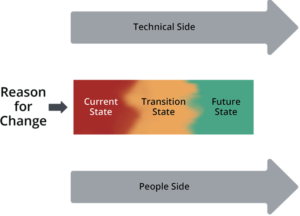Prosci is a change management methodology. Change is the only thing permanent in every space and hence there is change management in every space I have worked: PMP, Scrum, SAFe, ITIL…
The purpose of this post is to review the basis and compare with other methodologies/models I know.
Prosci methodology
Prosci Methodology is composed right now by 3 components:
- PCT Model: establishing and connecting the most important aspects of any successful change effort.
- ADKAR Model: a model for guiding individuals through the experiences—or elements—needed to make the change.
- Prosci 3-Phase Process: – a structured framework for driving change at the organizational level.
Prosci Change Triangle (PCT) Model
The triangle has 3 vertices and on each vertice PTC defines:
- Leadership/Sponsorship: the direction and guidance for a project, including who is accountable for defining why a change is happening, how it aligns with the direction of the organization, and why it is a priority.
- Project Management: the discipline that addresses the technical side of a change, by designing, developing and delivering the solution that solves a problem or addresses an opportunity, within the constraints of time, cost and scope
- Change Management: the discipline that addresses the people side of the change, enabling people to engage, adopt and use the solution.
The fourth factor of the model is success and is drawn in the middle of the triangle.
For those who are used to work with PMI principles we all know how this work on a program or project.
- The sponsor of a program defines the direction and provides the resources to implement the change. The definition of the stakeholders, a stakeholders management document with RACI, definitions and expectations covers also many parts.
- Integration management is a knowledge area present on PMI and frequently the more complicated one to implement, many things are related to change, alignment and integration of other components of a project.
- The The PCT Assessment seems to be like the project initiation where you define the main assumptions, goals and basic components of an initiative.
ADKAR model
ADKAR describes stages that employees must be guided through for successful change results:
- Awareness of the need for change
- Desire to support the change
- Knowledge of how to change
- Ability to demonstrate skills and behaviors for the change
- Reinforcement to sustain the change
This reminds me to the strategy cycle proposed by Wardley Mapping. Wardley Mapping recognizes the existence of uncertainty, the need of action in presence of uncertainty, the need of understanding the prevalent doctrines which dominates the behavior of an organization.
I assume that ADKAR is an iterative process as the context changes, what I need to discover is how they go through this ADKAR loop in detail.

ADKAR says “Organizational change requires individual change” and that the activities for moving individuals through ADKAR transitions happen during Phase 2 – Manage Change of the “Prosci 3-Phase Process”. So let’s see what it offers.
Prosci 3-Phase Process
It’s defined as a structured process for driving organizational change. The 3 phases are:

I have added the steps of other Change Management processes to link the different concepts.
I found this diagram that I find interesting:
Technical side is executed by the project management discipline.
Organizational change requires individuals to move from the current state to the future state—which requires managing both the technical side and people side of the change.
People side is executed by the change management discipline

I’m curious what is the proposition about how this should be done.
Change Management Office
Prosci recognizes that need of having a change management office (CMO). All I have read contains similarities of a PMO: with processes for governance and administrative activities and ITIL change management processes, where the right tracking and decisions are done on each relevant step of the business.
Management of resistance to change
They offer 5 tips for managing resistance to change (inertia). I understand that to manage the inertia there are other recommendations. If we compare this with Wardley Mapping, where Simon identified 16 different types of inertia at the organization level and he defined a set of potential actions to remove that resistance. We can see the perspective here is different:

When reading the 5 tips the first time, it gives me the impression of being a top-down forced approach where I have not seen how the proposed changes engages and emphasize with the people of the organization.
10 Aspects of change management impact
This is provided in a 17 pages document where they describe these aspects as critical.

Source: prosci.com